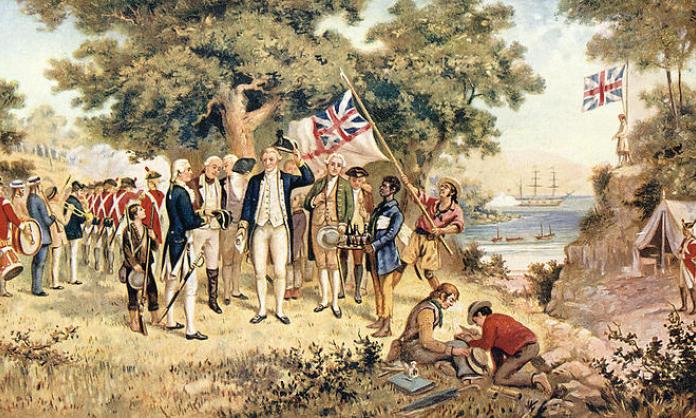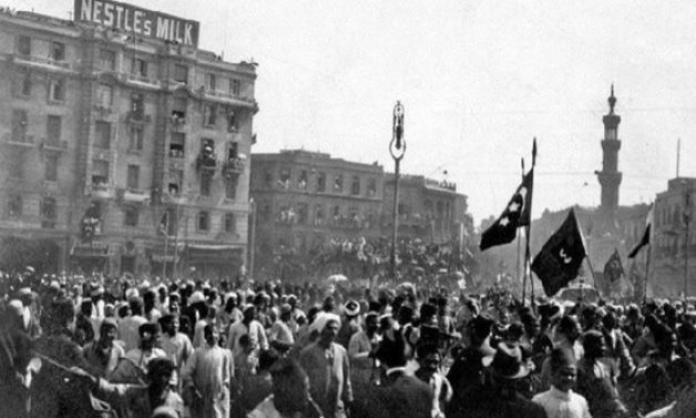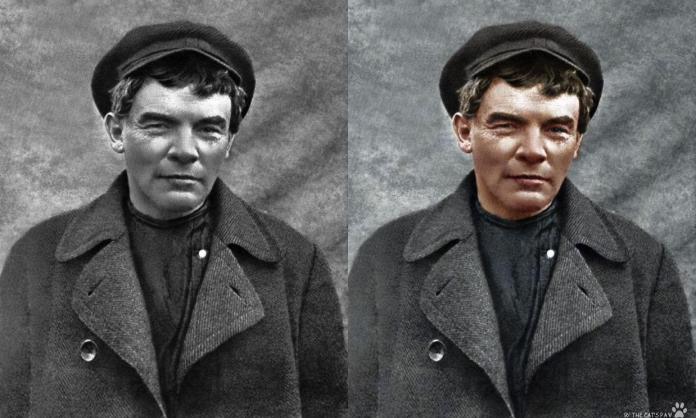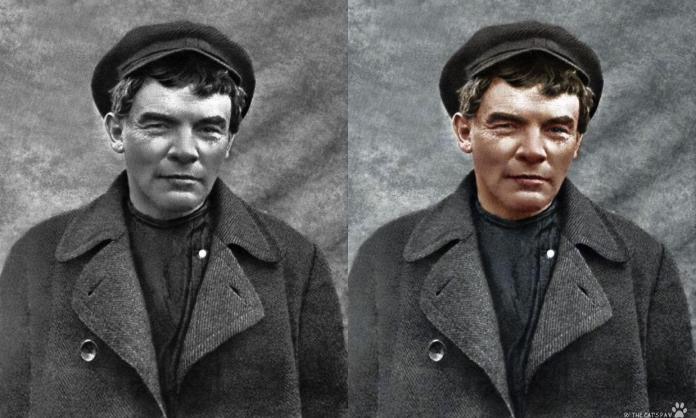In January 1788, the eleven ships of the First Fleet made landing at what was later named Sydney Cove in New South Wales. The ships carried 1,373 people from Britain, around half of whom were convicts, to form the basis for the first colony in Australia.
Those who designed the colony cared little for the original inhabitants of the land, and indeed justified the decision in part on what they (incorrectly) perceived as the ease with which the Aboriginal people could be dispossessed.
But while the colonisers agreed that it would be easy to dispossess local Aboriginal people, it was not the main motivating factor for the decision.
For many years there has been a debate about the motives behind the Botany Bay colony. Historian Geoffrey Blainey was among the first in the 1960s to argue that access to resources was the key motivation. Alan Frost argued that the colonisation of Botany Bay was driven by naval strategy. This was in contrast to the more established idea, put forward by the likes of Manning Clarke and Eris O’Brien, that the crisis in the British prison system was the overarching factor in the decision.
The true answer is some combination of these. While the decision to establish a penal colony was overwhelmingly driven by crisis in the British penal system, the dynamics of capitalism meant that empire was also a consideration.
It is difficult to overstate the social crisis that existed in the British prison system in the late eighteenth century. It was driven by the crisis caused by the transformation of British society from the old feudal order into a capitalist society.
Since the end of the English Civil War in the mid-1600s, capitalism had come to dominate British society. The capitalist class had undertaken the transformation of society in the interests of commerce and profit.
The capitalist state tore apart the social safety net that had existed under feudalism. Common land was enclosed, customary law was dismantled, price controls on food were abolished, and social customs such as the taking of game were redefined as theft, making them punishable offences.
People fled from the countryside to the city, as traditional means of providing a livelihood disappeared. From the beginning to the end of the eighteenth century, London’s population swelled from 630,000 to over a million, but it provided no meaningful social support for those who lived in it.
There was massive social dislocation: this social reorganisation was not done in the interests of the mass of commoners, but to make a place pliant to the needs of capital and profit making. Many were thrown into poverty, and it was not uncommon for even those with regular employment to need to supplement their income through theft and petty crime.
Criminologist Douglas Hay has described this social upheaval as accompanied by a massive increase of repressive state power through the penal code, as the capitalist class sought to cement its rule, entrench private property and discourage any popular resistance. Between the seventeenth and nineteenth centuries, hundreds of offences became punishable by death, most of them crimes against property. Many sentences were commuted to transportation and hard labour.
Unsurprisingly, prison populations soared as a result, and conditions in the prisons were unsanitary and insecure.
Initially, Britain dealt with its swelling prison population by transporting convicts to the American colonies as indentured labour. But in 1775-76, tensions between the American colonies and the British Empire bubbled over into the American War of Independence, and the transportation of convicts promptly stopped.
Temporary measures were put in place to deal with the situation, most infamously the establishment of horrific prison hulks. These ships were floating prisons, placed in the Thames and other navigable rivers. During the day, prisoners performed hard labour, raising sand and gravel from the riverbed. By night, they returned to the hulks, which were overcrowded floating houses of unspeakable misery.
Robert Hughes described the hulks as breeding grounds for corruption, bribery and deprivation. On arrival on the hulk, the captain and prison wardens would fleece the prisoners of their belongings, and extract every shilling and penny they could as bribes for small conveniences.
A prisoner could even have the weight of the iron lessened and the clasp loosened if they paid a warden’s bribe for “the easement of irons”.
The forced labour was hard and often watched by a crowd of onlookers. The wardens cared little for the wellbeing of the prisoners, and prisoners were assigned to work regardless of their physical condition.
Sir Jerome Fitzpatrick, an opponent of the prison hulks, described those in the hulk as having “bad and filthy bedding”, some “not having half the covering of their bodies [and] the privation of the nutritious part of their diet” through insufficient rations. Clothing was not suitable to the cold climate, and the requirement to work “indiscriminate”:
“[Men] with complete and painful Testicular Ruptures hanging towards their knee—without trusses, yet in common yoked in the Carts; the asthmatic and swelled or ulcerated legg’d subjects equally employed; the tender and painful-eyed at Lime Burning—on the whole I seldom could discover a rational system in respect ... to the exercise of reason and humanity in its application.”
The prison hulks were deeply unpopular, and escapes and prisoner riots were common. In 1786, eight prisoners were killed and 36 injured in a hulk riot. By this stage, the British ruling class needed a permanent solution to the penal problem. It had already lost the American colonies, and even the hulks could not house the prisoners produced from its bursting prison system.
The underlying motivation for the decision to establish a penal colony was undoubtedly the acute crisis in the British prisons. But what about some of the other factors historians point to, such as naval rivalry and imperial tensions?
While these were not the underlying reason for the decision, jostling between states certainly played a role in all of the locations that were considered for penal colonies.
During this era, the British Empire was engaged in naval rivalry with other European powers, most significantly the Dutch and the French. The Dutch had managed to establish a significant colonial empire, and they controlled important ports and trade routes that the British were reliant on.
Indeed, as well as being at war with the rebellious American colonies, Britain was also soon at war with France (1778), Spain (1779) and Holland (1780). This was an era in which the powers of Europe were pressing hard for imperial advantage over their rivals.
Historians such as Alan Frost are right that all of the locations considered for a British penal colony were considered in terms of their strategic advantage for the British Empire. John Gascoigne also describes discussions in the ruling class about the location for a penal colony being meshed with broader strategic and commercial goals.
For example, Das Voltas in south-west Africa was for a time the preferred location because it would reduce British dependence on Dutch ports in the Cape of Good Hope. It was only after Das Voltas was found to be inhospitable desert that the plan was abandoned.
While Botany Bay did not have some of the key advantages of some of the other locations, its proponents sought to justify it in terms of imperial strategies.
For example, James Matra had been a seaman on the Endeavour, and he argued that a colony in Botany Bay could act as a strategic base to challenge the Dutch in the East Indies and the Spanish in the Philippines and South America. These claims were echoed by naval officer Sir George Young, who argued that it would be an ideal location from which to entrench and defend the interests of the British Empire. In their efforts to court favour for the colony, they wildly exaggerated the proximity of Botany Bay to other key ports such the Cape of Good Hope and Madras.
However, Botany Bay did not rank highly in comparison to other potential destinations. This was partly because so little was known about it—European experience of it had at best been fleeting. The distance from England to Australia was long, and it would take many months to make the journey. Moreover, this would make it an extremely expensive enterprise, particularly if the colony needed financial assistance from the Treasury to support itself. As Molly Gillen has pointed out, this made many in government doubtful the cost would be worth any strategic gain Botany Bay offered.
Indeed, from the end of transportation to the American colonies in 1775 until the eventual decision on Botany Bay in 1786, a series of other more preferable proposals were tried and abandoned. Various ideas had included Jamaica, Nova Scotia, British Honduras and British forts in Africa; even Portuguese and Dutch colonies were considered. Gambia, South Africa and Das Voltas Bay were all explored as options for a penal colony, but were abandoned as too harsh an environment for a British settler colony—even a penal one.
Eventually the British ruling class ran out of options for exporting their convicts. In the end, all that remained was what Robert Hughes described as a “mediocre” final option: Botany Bay. It did still have some advantages, though. As the government wrote in its letter to the East India Company advising it of the decision, a colony at Botany Bay would prevent “our European neighbours” from “establishing themselves in that quarter”. Even a penal colony would establish a British claim to the land.
And so it was decided to load 775 convicts onto ships and launch them halfway around the world, to endure the terror and horrors of forced labour in Botany Bay.
The colony truly was a horror for many transported there, particularly in the early years. It was disastrously planned: in their keenness to export the human suffering from British prisons, almost no consideration was given to what would be needed to establish a successful colony. So in the First Fleet, there were almost no convicts who had any skills that would be relevant to establishing successful farms. Out of sight was out of mind, and on the other side of the world, Botany Bay became a dumping ground for the human waste of the British penal system.
Robert Hughes’ Fatal Shore describes the horrors of the early colony: constantly on the brink of starvation, convicts were subjected to horrific punishment by those who ruled them, and had no meaningful way to escape back to where they came from. For many years, the colony survived only on sporadic aid from England.
The colony also failed to become the naval or strategic base its proponents had so desired. In 1803, the French considered it so weak it could easily be captured, and it played no role in naval expeditions for years to come.
Eventually, the colony would become established as a successful part of the British Empire. But in its early days it was a site of bitterness and misery for the hundreds of people dumped there by their rulers.










